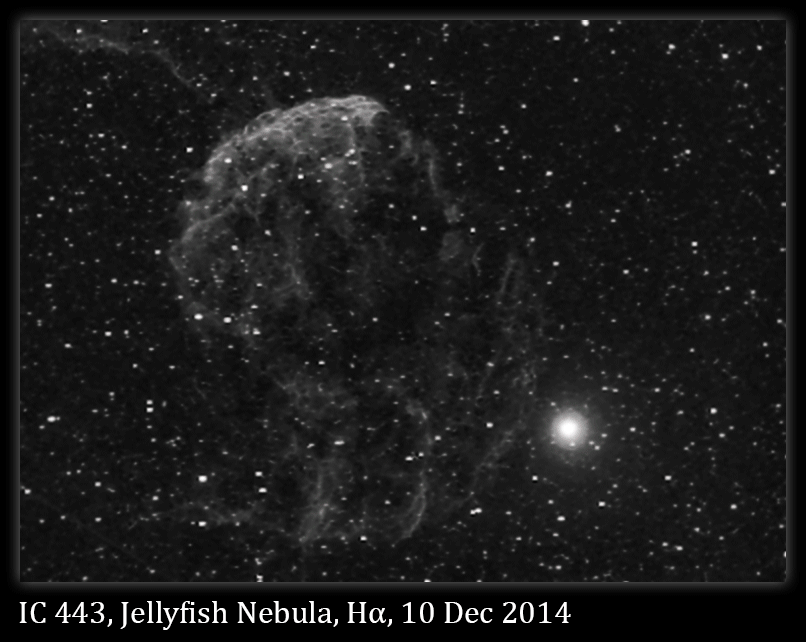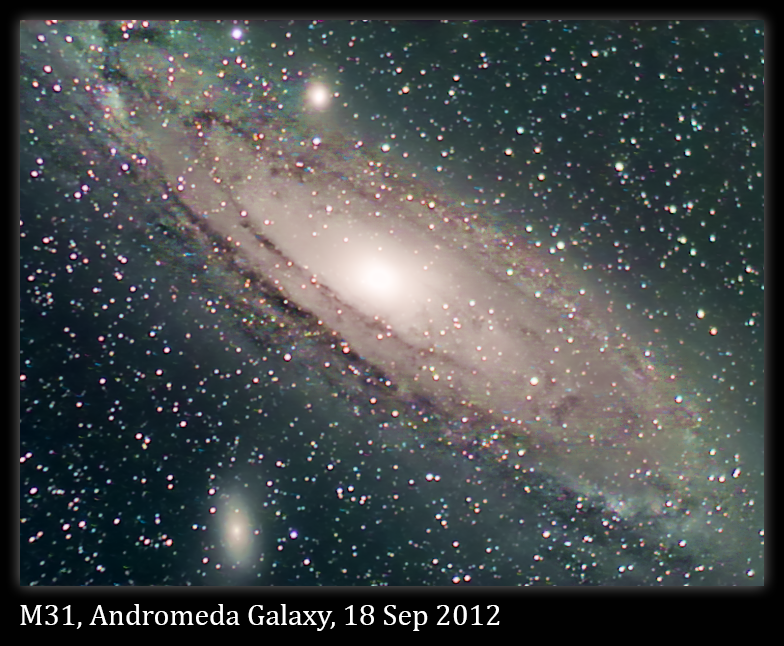First, I returned to the Crab Nebula, the famous remnant of the supernova observed by the Chinese in 1054. The Crab is a bit small for the focal lengths available to me, so I used my coma corrector, which increases the focal length by about 10%. Of course this is also my most challenging situation for guiding both because of the increased magnification and because the focuser has to be racked way out with the relatively heavy coma corrector in place. Conditions weren't great as a good winter storm was on its way so there were a few high clouds preceding the storm. I synched from β Tau and the PicGoto as usual was right on. I stopped a few times to refocus; the focus kept shifting as the temperature went down, but finally stabilized. I was expecting the mount to bump around 2:30 AM, but it missed so I continued getting decent data until M1 moved into the neighbor's trees. I threw out a bunch of subframes due to clouds and some trailing, but still got 51 that were usable. I aligned and combined these with 38 I had taken previously (19 Dec 2012) to get my deepest, richest Crab so far.
Date: 21 Nov 2014
Subject: M1, Crab Nebula
Scope: AT8IN + HPS Coma Corrector
Filter: Baader Planetarium Fringe Killer
Mount: CG-5 (Synta motors, PicGoto Simplificado)
Guiding: 9x50 Finder/Guider + DSI Ic + PHD 2.3.1l (Win 7 ASCOM)
Camera: DSI IIc no chiller 8 °C
Acquisition: Nebulosity 3.2.1, no dither
Exposure: 51x300 s + 38x300 (19Dec12)
Stacking: Neb 3, bad pixel map, bias included, 49 flats, normalize, deBayer & square, trans+rot align, 1.5 SD stack.
Processing: StarTools 1.3.5.289 Crop; Wipe: Aggressiveness 94%, Drop off point 40%; Develop 85.22%; HDR:Core reveal; Color:Scientific, 300%; Life:Moderate; Deconvolute: 3.0 pix; Track 3.2 pix; Magic 2 pix. Photoshop CC 2014 + Carboni Astronomy Tools healing brush; Increase star color; Layer masked levels; Layer masked less crunchy more fuzzy; Astroframe.
The storm and clouds came, followed by a warm period with frustratingly "almost good enough" weather characterized by frequent high clouds. I finally got out and attempted the Jellyfish nebula, another supernova remnant. According to Wikipedia, the explosion of this star would have been detectable on Earth between 3000 and 30,000 years ago; there is no record of it being observed. In any event, it is an older remnant than the Crab, which is still less than 1000 years old. Imaging is challenging because the bright star η Geminorum is in the field of view. For this object I wanted to largest field of view I have, which is what I get with the ST-80 refractor combined with a 0.5x focal reducer (which actually gives a reduction of 0.65x when mounted on my camera nosepiece; any additional reduction causes nasty aberrations). I already had RGB data from last February. I wanted to see what the Jellyfish looks like in Hα this time and was not disappointed. I had a hard time getting a plate solve through the main imager (I always seem to have a harder time with plate solves when using the Hα filter), but eventually I got it to work and got on target with the Astrotortilla/PicGoto combination. I didn't even look at the CCD temperature, but it was a warm night for December in Utah. The session started with clear skies, but the sky got progressively worse and by about 1 AM when I went out to check on doing a meridian flip there were high, thin clouds almost everywhere. What follows is an animation showing the Hα in grayscale and in false color.
Date: 10 Dec 2014
Subject: IC 443, Jellyfish Nebula
Scope: Orion ST-80+Antares 0.5x focal reducer
Filter: Baader Planetarium Hα
Mount: CG-5 (Synta motors, PicGoto Simplificado)
Guiding: 9x50 Finder/Guider + DSI Ic + PHD 2.4.1 (Win 7 ASCOM)
Camera: DSI IIc no chiller ~8 °C
Acquisition: Nebulosity 3.2.1, no dither
Exposure: 26x600 s
Stacking: Neb 3, bad pixel map, bias included, no flats, OSC extract R, normalize, square, trans+rot align, 1.5 SD stack.
Processing: StarTools 1.3.5.289 Crop; Develop 79.84%; HDR:Optimize; Deconvolute: 3.0 pix; Contrast; Life:Moderate; Track 4.6 pix; Magic 1 pix. Photoshop CC 2014 + Carboni Astronomy Tools Make stars smaller; Hα false color black sky; Astroframe.
Next I tried combining the Hα with my RGB data. First, here is the RGB image so you can see where I started. There are a lot of background stars, and most of the nebulosity is faint.
One way of combining is to simply use the Hα as luminance. That dims the background stars, which are not as bright in Hα, and brings up the Hα-emitting nebulosity. That is shown here:
This image combines Hα data from 10 Dec 2014 with RGB data from 25 Feb 2014. In this case, I used Hα for luminance and the straight RGB image. It doesn’t look nearly as good, in my opinion, as in the Starizona method below, which combines the Hα with R and uses that for both luminance and the R channel.
A more sophisticated method is to mix the Hα with the original R, and use that for both R and luminance. I refer to this as "Starizona Method 1," as it follows the instructions at this link. I also use the Photoshop channel mixer to boost the HαR after doing this, to prevent all my stars from being bluish. Typically I boost to 200%. This is HαRRGB, and I think it looks the best of all.
This image combines Hα data from 10 Dec 2014 with RGB data from 25 Feb 2014. I roughly followed Starizona method 1 (the difference being I use the channel mixer in Photoshop to boost the HαR to 200%), but I’m still struggling with blending Hα and RGB. The dimmer stars always come out looking blue with this method, I presume because when the HαR is made the dimmer stars don’t show up, so if the HαR is used for the R channel the dim stars don’t have enough R. I don’t know how to fix this currently. However, this definitely looks a lot better than the RGB alone did, and actually has better color than using Hα luminance with straight RGB.



























